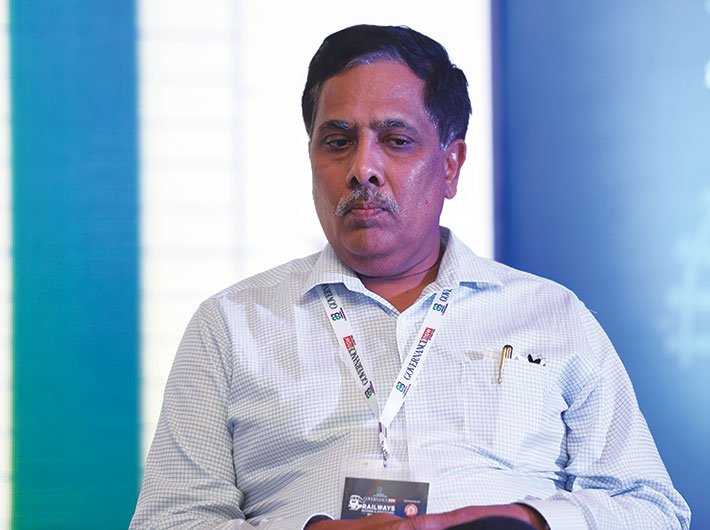Railway Board’s member Rajesh Agrawal talks about plans to enhance the passenger experience and the recently launched Vande Bharat Express.
The Indian Railways is going for a huge overhaul to make travel more comfortable – from upgrading AC and non-AC carriages to retrofitting of bio toilets. In a tête-à-tête with Vishwas Dass, the Railway Board’s member (rolling stock) Rajesh Agrawal talks about plans to enhance the passenger experience. He also talks about the recently launched Vande Bharat Express.
What are the key projects under passenger segment that the Indian Railways will execute?
The railways has been focusing on upgrading premium trains like Rajdhanis and Shatabdis. All Rajdhanis and Shatabdis would be upgraded to Swarn standards before March 2019 to improve passenger experience. The Swarn standards are about improving coach interiors, toilets, on-board cleanliness, punctuality, catering, linen, staff behaviour, security, on-board entertainment and real-time feedback. The railways will roll out other series of trains like Antyodaya, Humsafar and Tejas in the coming months. The older Integral Coach Factory-manufactured 100 coaches would be upgraded to Utkrisht category by March this year and 500 carriages would be rolled out by the end of 2019-20.
The railways has been planning to upgrade mainline electrical multiple units (MEMUs) and diesel electrical multiple units (DEMUs). To give better travel experience to people travelling in unreserved coaches, the railways plan to replace all the slow moving trains with MEMU trains for which there is a requirement of 6,000 coaches, which would be manufactured in the next five years. To meet the 2018-19 fiscal requirement, the railways will make 1,200 MEMU-type coaches to operate in the golden quadrilateral which is the most congested section of the Indian Railways. It will also upgrade the designs of DEMU, MEMU and electrical multiple unit (EMU) trains. EMU service was introduced 91 years ago and since then the same train has been running; now it will be upgraded.
We have undertaken a never-seen-before mobilisation drive where the railways is monitoring all of its 70,000 passenger coaches on computer across the board. There are around 10 key areas that require incremental improvement and the railways would be doing most of it before the end of current fiscal. As an instance, fitting of 100 percent bio toilets in the coaches would be completed by June 2019, which is perhaps the largest Swachhata exercise in the country. The railways plans to stop unloading of night soil and urine and make all railway stations stench-free. Another area is eliminating jerks in the coaches, fitting vacuum toilets and ensuring quick watering arrangements to fill up water tanks of coaches in quickest time. There are plans to introduce automatic coach washing plants in more than 100 locations. The idea is that basic minimum standards should be maintained and then the transporter must turn its focus on the aspirational standards. Train 18 which is recently christened as Vande Bharat Express is one such example of aspirational standards of the Indian Railways.
Some passengers throw litter in bio toilets while travelling in trains. Is the ministry taking any measures to sensitise people?
We have been using that hole of toilets as dustbin for almost three or four generations and it was taken for granted. This was a cultural mindset for several generations and changing that mindset cannot happen overnight. The railways has put bio toilets display boards at stations to make people aware of the features and on the windows of toilets so that a person knows that this is a bio toilet and trash should not be thrown in it. The awareness is certainly increasing and the railways is using media in a big way for this purpose.
How is the railways focusing on maintaining cleanliness at stations?
The top brass of the railways are working as commander-in-chief and they are monitoring everything to improve services. The cleanliness work is being taken on a war footing. Even parliamentarians coming to the national capital through trains have given their positive feedback on cleanliness. The railways is focusing on cleanliness, facilities, ambience, amenities, signage and removal of foul smell in and around station premises.
What will be the actual operational speed of Vande Bharat Express?
We have tested Train 18 or Vande Bharat Express up to maximum 180 kmph and the track is not permitting us to run it beyond the said speed limit. In case we get better tracks, we can run it even beyond 180 kmph. To run this train at 160 kmph we need fencing along the tracks. The railways has planned to run it at a maximum track speed of 130 kmph and in some stretches it is permitted to run at 110 kmph. Track upgradation work is an ongoing process. The current standard for track maintenance is known as C&M1 volume 1, which is fit for 160 kmph. Vande Bharat Express can run with a maximum speed of 160 kmph only if the railways has a complete stretch of C&M1 volume one standard. The second rake of Train 18 will be rolled out by March 2019. The railways is likely to manufacture sleeper class coaches for Train 18 in the coming years.
It is said that a lot of countries have expressed interest in ICF-manufactured self-propelled Vande Bharat after it successfully completed speed test of 180 kmph.
Such dialogues are in process. A lot of policy changes are required before we can actually streamline the process. We have already proposed the streamlining of a very large number of procedures and in case all of it goes through then perhaps exports can be done. But nothing is finalised as yet.
What is the contribution of Indian Railways in the Make in India initiative? At what scale is the centre’s flagship scheme being exploited by the railways?
Indian Railways has given a major impetus to the centre’s Make in India initiative. The coaches that we manufacture are more than 90 percent indigenous. We have just that little portion of components which is imported under technological exchange. We have been making LHB coaches for around two decades and about 5,500 coaches were built in the last 17 years. One will be surprised to know that the railways has manufactured over 5,000 coaches in the last two-three years, which is exceptional. So what we had done in the last 17 years, we have done it in the last two years which is entirely Make in India. Much of this technology that we are imbibing; we are going to own it.
vishwas@governancenow.com
(This interview appears in the March 15, 2019 edition)

